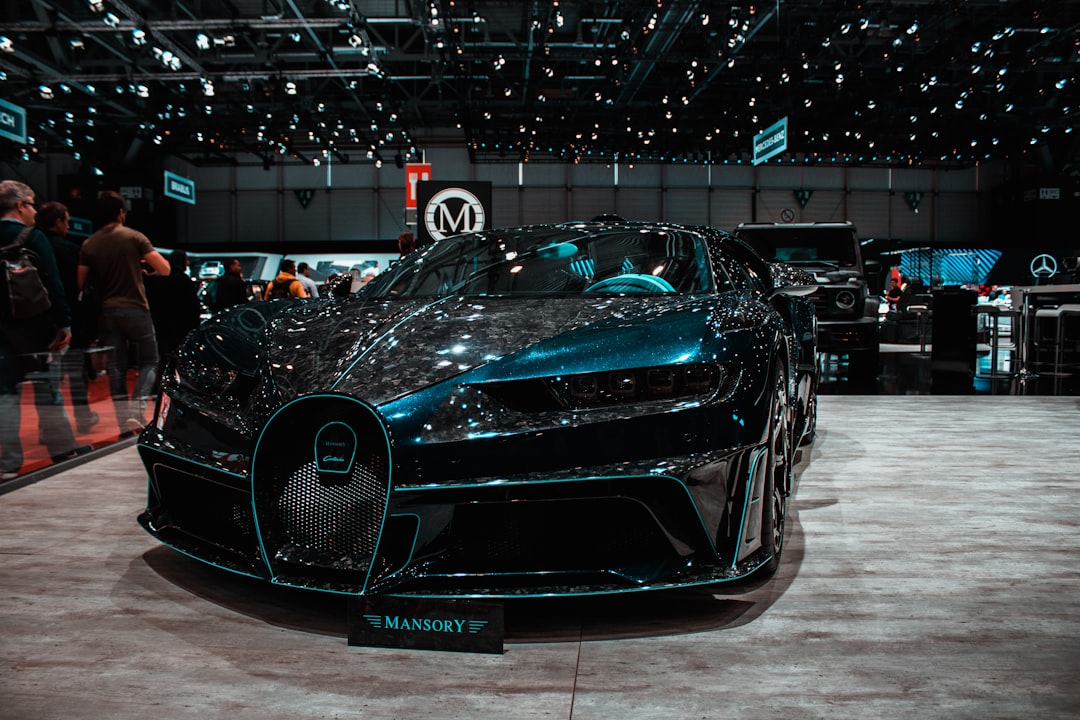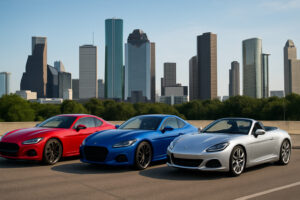bugatti chiron technical specifications: 10 Powerful Facts 2025
The Engineering Masterpiece Behind the Speed
Ever wondered what makes the Bugatti Chiron so special? The bugatti chiron technical specifications tell a story of automotive excellence that goes far beyond mere numbers. This hypercar isn’t just fast—it’s a symphony of precision engineering and artistic vision.
Let me break down the essentials for you:
| Specification | Details |
|---|---|
| Engine | 8.0L quad-turbocharged W16 |
| Power | 1,479 hp (1,103 kW) at 6,700 rpm |
| Torque | 1,600 Nm (1,180 lb-ft) at 2,000-6,000 rpm |
| Acceleration | 0-100 km/h (0-62 mph) in 2.4 seconds |
| Top Speed | 420 km/h (261 mph) electronically limited |
| Transmission | 7-speed dual-clutch automatic |
| Drivetrain | All-wheel drive |
| Weight | 1,995-2,043 kg (4,400-4,504 lbs) |
| Production | Limited to 500 units (2016-2023) |
The Chiron faced a daunting challenge from day one: improving upon the legendary Veyron—a car that had already redefined what was possible in automotive engineering. As Christophe Piochon, President of Bugatti Automobiles, puts it: “In every respect, it must excel – not just fast, but beautifully designed, constructed from the finest materials, usable in all conditions and at all times, and comfortable during long journeys.”
What truly sets the Chiron apart isn’t just the headline-grabbing top speed or its monstrous horsepower. It’s the incredible attention to detail in every aspect of its engineering. The carbon fiber monocoque boasts a torsional stiffness of 50,000 Nm per degree—a figure that would make aerospace engineers nod in appreciation.
Heat management? The Chiron employs not one or two, but ten separate radiators working in harmony to keep temperatures in check. And that exhaust system isn’t just pipes and catalytic converters—it’s a masterpiece with six catalysts covering an area equivalent to 30 football fields. That’s right—football fields!
Each Chiron is a unique creation, assembled by hand in Bugatti’s historic Molsheim workshop in France. Around 1,800 individual parts come together over months of meticulous craftsmanship, followed by up to six months of testing before the keys are handed to its fortunate owner.
As Hendrik Malinowski from Bugatti beautifully notes: “Each one is configured individually and produced by hand according to the customer’s wishes.” No two Chirons are identical—each one is as unique as its owner’s fingerprint.

Engine & Drivetrain: The Heart of a W16 Monster
When you first hear a Bugatti Chiron roar to life, you’re not just listening to an engine – you’re experiencing automotive history in motion. The legendary 8.0-liter quad-turbocharged W16 engine stands as perhaps the most ambitious powerplant ever fitted to a production car.
Having spent time with this extraordinary machine at Car News 4 You, I can tell you that words rarely do justice to the sensation. The W16 creates a unique gravitational pull that presses you firmly into the handcrafted leather seat. That distinctive sound – beginning as a deep, throaty growl before changing into something eerily similar to a fighter jet – announces the arrival of 1,479 horsepower and 1,600 Nm of torque.
W16 Configuration & Displacement
The genius of the “W” configuration lies in its compact packaging. Imagine two VR8 engines joined at a 90-degree angle, creating 16 cylinders in a space where most manufacturers would struggle to fit 12. The massive 8.0-liter (7,993 cc) displacement comes from a perfect-square bore and stroke of 86 mm × 86 mm, with each cylinder housing 4 valves.
What truly sets this engine apart is its quad-turbocharger arrangement. Unlike conventional twin-turbo setups, the Chiron employs a sequential system where two turbochargers engage at lower RPMs (eliminating the dreaded turbo lag), while the remaining two activate at higher RPMs to deliver the full, face-melting power band. This clever engineering ensures that massive torque is available from just 2,000 RPM all the way to 6,000 RPM – creating that characteristic, seemingly endless Bugatti acceleration.
The engine block itself represents metallurgical mastery, designed to withstand thermal and mechanical stresses that would quickly destroy lesser engines. Even the firing order has been precisely calculated to balance the engine’s forces and minimize vibration, despite generating power that would embarrass many race cars.

Horsepower & Torque – bugatti chiron technical specifications in numbers
The raw statistics of the Chiron are simply mind-boggling. The standard Chiron produces 1,479 hp (1,103 kW) at 6,700 RPM and 1,600 Nm (1,180 lb-ft) of torque from 2,000 to 6,000 RPM. To put this in everyday terms, that’s roughly the combined power of 15 family sedans crammed into one exquisite package.
This astronomical output creates unique challenges. The cooling system alone is a marvel of engineering – 10 separate radiators handling over 60,000 liters of air and 800 liters of water per minute. Without this sophisticated thermal management network, the W16 would quickly cook itself under full power.
Before any engine is installed in a Chiron, it undergoes 8 hours of punishing testing on specialized benches that simulate conditions far more extreme than most owners will ever encounter. This explains how Bugatti can offer both mind-bending performance and surprising reliability.
For those who somehow found the standard Chiron insufficient, the Super Sport variants push boundaries even further with up to 1,578 hp (1,177 kW). Bugatti achieved this through larger turbochargers, improved oil pump capacity, and additional cooling measures, as detailed in scientific research on powertrain cooling.
Transmission & All-Wheel Drive
Transmitting the Chiron’s seismic power to the pavement requires equally sophisticated drivetrain components. The 7-speed dual-clutch transmission (DCT) was specifically engineered to handle the engine’s massive torque while delivering shifts measured in milliseconds.
The dual-clutch design employs two separate clutch assemblies – one for odd-numbered gears and one for even-numbered gears. This allows the next gear to be pre-selected while the current gear is engaged, enabling those lightning-fast shifts that feel instantaneous from behind the wheel.
Power reaches all four wheels through a highly advanced all-wheel-drive system. The Haldex-type center differential continuously varies torque distribution between front and rear axles based on driving conditions, available traction, and driver inputs. During normal cruising, the system favors the rear wheels for a more engaging driving experience, but can instantly redirect power forward when needed for stability or grip.
Perhaps the most impressive party trick in the Chiron’s arsenal is its launch control system. When activated, this electronic orchestra conductor holds the engine at optimal RPM while precisely managing clutch engagement and power distribution. The result? The ability to rocket this two-ton hypercar to 100 km/h in just 2.4 seconds, repeatedly and reliably – something that would have seemed impossible a generation ago.
Materials, Chassis & Handling Innovations
Beyond its powertrain, the Chiron isn’t just an engine with a car wrapped around it—it’s a symphony of cutting-edge materials and chassis engineering where every component plays a crucial role in both performance and luxury.
Carbon & Titanium Construction
At the heart of the Chiron sits its carbon fiber monocoque structure—a masterpiece of materials science that provides incredible rigidity while keeping weight to a minimum. This isn’t your average carbon fiber, either. Bugatti uses a specialized layup process involving over 320 square meters of carbon fiber sheets. Here’s a mind-blowing fact: if all these fibers were stretched end-to-end, they’d reach the moon and back four times!
The result? A torsional stiffness of 50,000 Nm per degree—a figure that would make many racing cars jealous. This incredible rigidity isn’t just about handling; it creates a protective cocoon around passengers when they’re traveling at speeds that would make most commercial airplanes blush.
When we at Car News 4 You examined the Chiron Sport up close, we were amazed by its carbon fiber windscreen wiper arms—a world first for a production car. This seemingly small detail saves 1.4 kg at the highest point of the vehicle, which might not sound like much until you realize how significantly it improves handling by lowering the center of gravity.
The exhaust system showcases Bugatti’s obsession with lightweight materials, employing titanium throughout to reduce back pressure while shedding precious grams. Perhaps most impressive is the 3D-printed titanium exhaust trim—another industry first—built from roughly 4,200 layers of metal powder fused by lasers. This manufacturing technique allows for geometries that would be impossible to create using traditional methods.

Suspension, Brakes & Tires – bugatti chiron technical specifications on the road
The Chiron’s handling capabilities match its straight-line performance thanks to its sophisticated suspension system. The car features a fully hydraulically adjustable chassis controlled by 18 hydraulic cylinders—technology similar to what you’d find in modern jets. This allows the Chiron to adapt its ride height and damping characteristics based on speed and driving mode.
Switch to handling mode, and the car hunkers down by 35mm while adjusting camber settings for maximum cornering grip. Insert the special Speed Key to access top speed mode, and the car lowers by 40mm at the front and 39mm at the rear, minimizing drag while maximizing stability.
The braking system is equally jaw-dropping. Massive carbon-ceramic discs (420mm front, 400mm rear) are gripped by titanium pistons—eight per caliper up front and six per caliper at the rear. The result? The Chiron screeches from 100 km/h to a standstill in just 31.4 meters—significantly shorter than most sports cars.
| Vehicle | Front Brake Size | Rear Brake Size | Material |
|---|---|---|---|
| Bugatti Chiron | 420mm | 400mm | Carbon-ceramic |
| Ferrari LaFerrari | 398mm | 380mm | Carbon-ceramic |
| McLaren P1 | 390mm | 380mm | Carbon-ceramic |
| Koenigsegg Jesko | 410mm | 395mm | Carbon-ceramic |
The Chiron rides on specially developed Michelin Pilot Sport Cup 2 tires, co-engineered specifically for the car’s performance envelope. Standard sizes are 285/30R20 at the front and 355/25R21 at the rear. For the more track-focused Pur Sport variant, Michelin created a special Cup 2R compound that increases lateral grip by a whopping 10%.
These aren’t ordinary tires—they withstand forces that would shred lesser rubber. At the Chiron’s top speed of 420 km/h, each tire spins at 4,100 rotations per minute while handling loads up to 3,800 kg. In fact, the electronically limited top speed isn’t due to engine limitations but rather what the tires can physically handle at such extreme velocities.
Aero & Cooling Tech
The Chiron’s aerodynamics are as carefully crafted as its engine. That distinctive C-shaped side line isn’t just a pretty design element—it’s a functional air intake channeling cooling air to the massive engine and brakes. This perfect marriage of form and function defines Bugatti’s engineering philosophy.
The active aerodynamics system centers around the rear wing, which serves multiple purposes. During normal driving, it stays hidden, maintaining the car’s clean lines. Slam on the brakes, and it deploys as an air brake, increasing drag and downforce to improve stopping performance. In top speed mode, it adjusts to a specific angle that perfectly balances downforce and drag for maximum stability.
Up front, carefully designed air curtains direct airflow around the wheels, reducing turbulence and drag. The completely flat underbody features rear diffusers that generate ground effect—essentially sucking the car to the road at high speeds.
The cooling system is perhaps the unsung hero of the Chiron’s performance. Ten radiators work in perfect harmony to manage heat from the engine, transmission, differential, and turbochargers. This system processes over 800 liters of water per minute—enough to fill your bathtub in about 11 seconds. This extensive cooling network ensures the Chiron maintains peak performance even when pushed to its limits—something we’ve experienced during our test drives for Car News 4 You.
bugatti chiron technical specifications: Dimensions, Performance & Efficiency
The Chiron’s physical dimensions create a perfect harmony between athletic prowess and grand touring comfort. It commands attention with its substantial road presence: 4,544 mm long, 2,038 mm wide, and standing just 1,212 mm tall, with a wheelbase of 2,711 mm. Despite Bugatti’s extensive use of exotic lightweight materials throughout the car, this engineering marvel still tips the scales between 1,995 and 2,043 kg depending on specification. This weight reflects the reality of housing such massive mechanical components alongside luxurious amenities within its sculpted frame.
Acceleration & Top-Speed Modes
The acceleration figures of the Chiron read more like science fiction than automotive specifications: 0-100 km/h disappears in just 2.4 seconds, 0-200 km/h in a mere 6.1 seconds, and 0-300 km/h in a breathtaking 13.1 seconds. Numbers on a page simply can’t convey the visceral, almost violent experience of such acceleration – it’s more comparable to being launched from an aircraft carrier than anything you’d expect from a road car.
What makes these achievements even more remarkable is that they come from a luxury grand tourer weighing over two tons – not some spartan, stripped-out track special. As Jason Barlow from Car and Driver so perfectly captured it, “The Chiron combines Bugatti’s signature brutal power with a level of comfort and handling never seen before in a hypercar.”
The standard Chiron’s top speed is electronically limited to 420 km/h (261 mph). This limitation exists not because the engine lacks power, but because of the physical limitations of even the most advanced tires at such extreme velocities. To access this full potential, owners must insert the special “Speed Key” which activates the car’s Top Speed mode. Without this key, the Chiron is “restricted” to 380 km/h – still faster than almost any other production vehicle on earth.
In 2019, Bugatti made history when a modified pre-production Chiron Super Sport 300+ driven by test driver Andy Wallace achieved an astonishing 490.484 km/h (304.773 mph), making it the first production car to break the 300 mph barrier. This record-setting car featured special aerodynamic modifications including a “longtail” design to reduce drag at these extreme speeds.
The Chiron also holds the record for the fastest 0-400-0 km/h run, completing this mind-bending acceleration and braking feat in just 41.96 seconds in 2017. This demonstrates not just the car’s ability to accelerate, but also its equally extraordinary capacity to shed speed safely.

Fuel Consumption & Emissions
With great power comes great thirst – and the Bugatti Chiron technical specifications regarding efficiency are as extreme as its performance figures. The official fuel consumption ratings tell a sobering story: 35.2 L/100km in urban driving, 15.2 L/100km in extra-urban conditions, and a combined figure of 22.5 L/100km.
To accommodate this prodigious appetite for premium fuel, the Chiron comes equipped with a massive 100-liter tank. Even so, at full throttle, this tank would be completely emptied in less than 10 minutes – though we suspect few owners regularly drive their multi-million-dollar hypercars flat out for extended periods!
The CO₂ emissions are rated at 516 g/km, firmly placing the Chiron in efficiency class G – the least efficient category in the European rating system. These figures honestly reflect the engineering priorities of the Chiron, which focused unabashedly on performance above all else.
Interestingly, these consumption figures actually represent an improvement over the previous Veyron, despite the Chiron’s significant increase in power output. This efficiency gain was achieved through improved engine management systems, reduced internal friction, and more advanced aerodynamics.
As we’ve been covering at Car News 4 You, even hypercars are beginning to incorporate more efficient technologies as automotive engineering evolves. We’ve been tracking the advancements in automotive 3D printing applications that are helping create lighter, more efficient components – technology that Bugatti has pioneered with elements like the Chiron’s 3D-printed titanium exhaust components.
The Chiron remains unapologetically excessive in every metric – exactly as a hypercar should be. It represents the absolute pinnacle of what’s possible when engineers are given free rein to create the ultimate expression of automotive performance, with little concern for mundane considerations like fuel economy.
Variants, Production History & Record Highlights
Throughout its production run from 2016 to 2023, Bugatti created several variants of the Chiron, each with unique characteristics and technical specifications. The total production was capped at 500 units, making the Chiron one of the most exclusive hypercars ever produced.
The standard Chiron established the baseline with its 1,479 hp output and 420 km/h top speed. In 2018, Bugatti introduced the Chiron Sport, which maintained the same power output but reduced weight by approximately 18 kg through the use of carbon fiber windscreen wipers, lighter wheels, and a lighter exhaust system. The Sport also featured a stiffer suspension setup and dynamic torque vectoring to improve handling.
The most significant performance upgrade came with the Chiron Super Sport 300+, unveiled in 2019 following the record-breaking 490.484 km/h run. This variant featured an uprated engine producing 1,578 hp, aerodynamic modifications including a “longtail” design, and a top speed of 440 km/h (electronically limited for production models).
For those more focused on handling than top speed, Bugatti created the Chiron Pur Sport in 2020. This variant featured a more aggressive aerodynamic package with a fixed rear wing, a 50 kg weight reduction, shorter gear ratios, and specially developed Michelin tires for improved cornering performance. The top speed was reduced to 350 km/h, but the car offered significantly improved agility and lateral grip.
The final production Chiron was the one-off L’Ultime, delivered in 2023 to mark the end of the model’s production run. This bespoke creation featured unique design elements and customizations requested by its owner, representing the culmination of the Chiron’s development journey.
Limited Editions & Bespoke Builds
Beyond the main variants, Bugatti created numerous limited editions and one-off builds to showcase the brand’s customization capabilities and celebrate its heritage.
The Chiron Sport “110 Ans Bugatti” was created in 2019 to celebrate the company’s 110th anniversary. Limited to just 20 units, it featured the French tricolor on various elements of the exterior and interior.
The “Les Légendes du Ciel” edition paid homage to Bugatti’s historic connection to aviation. Limited to 20 units, it featured a matte gray exterior with a blue-tinted carbon fiber interior and special embossed leather featuring portraits of early Bugatti racing drivers who were also aircraft pilots.
Through the “Sur Mesure” customization program, Bugatti created numerous one-off Chirons with unique paint schemes, interior treatments, and bespoke details. The “Golden Era” edition featured hand-drawn sketches of iconic Bugatti models on its exterior, while the “Type 55” edition referenced one of Bugatti’s most famous pre-war models.
The Chiron Noire was offered in two versions – Sportive and Élégance – inspired by the legendary “La Voiture Noire” of the 1930s. These editions featured unique black finishes on various components and were limited to just 20 units.
Perhaps the most distinctive variant was the Chiron Profilée, which was originally intended to be a series production model positioned between the Chiron Sport and Pur Sport. However, by the time it was developed, all 500 Chiron build slots had been allocated. Bugatti built just one example, which was auctioned in 2023 for €9.8 million, making it the most expensive new car ever sold at auction.
Manufacturing Milestones
Each Chiron represented approximately 1,800 individual parts assembled by hand at Bugatti’s atelier in Molsheim, France. The production process was meticulous, with each car taking up to two months to build followed by up to six months of testing before delivery.
The 100th Chiron was completed in 2018, marking the first fifth of the production run. By 2020, Bugatti had delivered the 250th Chiron, reaching the halfway point of production. The 400th unit was completed in 2021, leaving just 100 cars to be built.
Throughout production, Bugatti maintained rigorous quality standards. Each powertrain was tested on a specialized bench for 8 hours before installation. After assembly, the cars underwent extensive testing, including a 300 km test drive on public roads and a high-speed test on Volkswagen Group’s Ehra-Lessien test track.
As Christophe Piochon noted, “The origins of the Bugatti brand lie in art and the innovative pursuit of technical excellence. This is unique in the automotive world. We are committed to this tradition and have brought it into the 21st century with the Chiron.”
Frequently Asked Questions & Conclusion
After diving deep into the extraordinary Bugatti Chiron technical specifications, I think it’s time we address some of the questions that keep popping up about this remarkable machine.
What is the exact power output in the bugatti chiron technical specifications?
The standard Bugatti Chiron delivers a staggering 1,479 hp (1,103 kW) at 6,700 RPM, with a mountain of torque measuring 1,600 Nm (1,180 lb-ft) available between 2,000 and 6,000 RPM. If that wasn’t enough to make your head spin, the Super Sport and Super Sport 300+ variants push things even further with 1,578 hp (1,177 kW) while maintaining that same tremendous torque figure.
This incredible power comes from what might be the most complex production engine ever created – the 8.0-liter quad-turbocharged W16. With 64 valves and direct fuel injection, this engineering marvel requires a cooling system with 10 separate radiators just to keep temperatures in check. Each engine weighs about 400 kg and is carefully assembled by hand by technicians who might have the steadiest hands in the automotive world.
How many bugatti chiron technical specifications variants exist?
Bugatti crafted five main flavors of the Chiron during its production run:
- The standard Chiron: The “base model” (if you can call it that) with 1,479 hp and a 420 km/h top speed
- Chiron Sport: Same power but lighter and more nimble, with improved handling for those curvy mountain roads
- Chiron Pur Sport: The track-focused variant that shed 50 kg and traded some top speed (350 km/h) for sharper cornering abilities
- Chiron Super Sport: Boosted to 1,578 hp with refined aerodynamics and a 440 km/h top speed
- Chiron Super Sport 300+: The record-breaker with its distinctive “longtail” design and the first production car to break the 300 mph barrier
Beyond these main variants, Bugatti created a gallery of limited editions and one-offs that would make any collector weak at the knees. The 110 Ans Bugatti celebrated the company’s 110th birthday, while Les Légendes du Ciel paid homage to Bugatti’s aviation connections. The Noire editions channeled the legendary “La Voiture Noire,” and the one-of-a-kind Profilée became the most expensive new car ever sold at auction, fetching €9.8 million.
How does it differ from the Veyron?
While the Chiron clearly evolved from the Veyron’s DNA, calling it a mere update would be like saying a space shuttle is just an upgraded airplane. The Chiron represents a comprehensive reimagining of what a Bugatti hypercar could be.
Compared to its predecessor, the Chiron delivers significantly more power (1,479 hp vs. the Veyron’s 1,001 hp), greater torque (1,600 Nm vs. 1,250 Nm), and faster acceleration (0-100 km/h in 2.4s vs. 2.5s). It also boasts a higher top speed of 420 km/h compared to the Veyron Super Sport’s 408 km/h.
But the improvements go far beyond raw numbers. The Chiron offers dramatically improved handling thanks to its stiffer carbon fiber chassis and better weight distribution. Its advanced aerodynamics with that active rear wing and improved cooling make it more stable at speed. Step inside and you’ll find a more sophisticated interior with modern digital displays and more intuitive controls.
As the folks at Top Gear put it: “The Chiron takes everything the Veyron did well and improves upon it dramatically. It’s faster, smoother, and more refined.”

In conclusion, the Bugatti Chiron technical specifications represent what might be the absolute zenith of internal combustion technology. Having followed the automotive landscape for years at Car News 4 You, I can confidently say the Chiron stands as a monument to what’s possible when engineers are given virtually unlimited resources and told to create something extraordinary.
With all 500 units now sold and production complete, the Chiron has cemented its place in automotive history. Its successor faces the daunting challenge of embracing electrification while somehow maintaining Bugatti’s performance legacy – a story we’re watching closely in our Luxury section.
For the fortunate few who have a Chiron in their collection, proper care is essential to preserve both performance and value. Our Ultimate Guide to Car Maintenance for 2025: From Basic to Advanced offers insights that apply even to the most exotic vehicles.
The Bugatti Chiron isn’t just a car – it’s a rolling laboratory, a masterpiece of design, and perhaps the ultimate statement of what’s possible when cost is no object and performance is the priority. In our increasingly electric future, the Chiron may well be remembered as the spectacular finale to the era of the internal combustion hypercar – a 16-cylinder, quad-turbocharged exclamation point at the end of an era.








